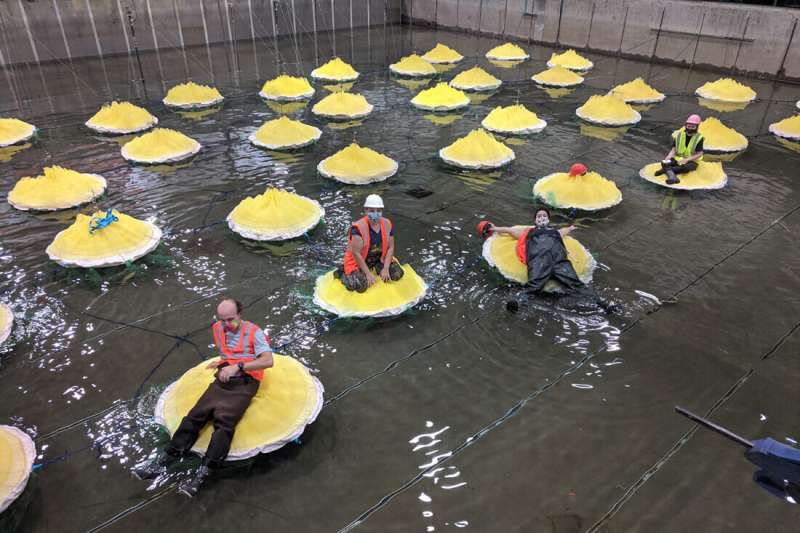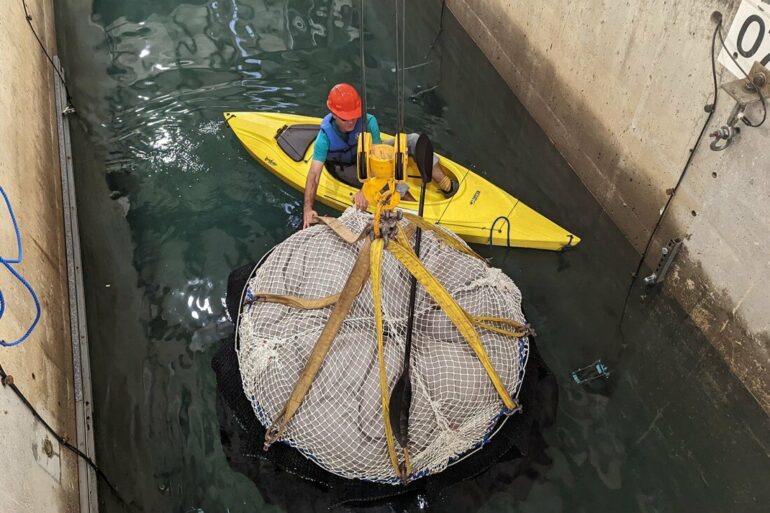Picture Boston Harbor, a few years from now. The East Boston Greenway, a leafy urban trail, no longer stops a block from the pier, but extends into the ocean. A floating semi-circular trail arcs across the water; cyclists buzz and pedestrians stroll along it.
This is more than a buoyant park. The real innovation surrounds the path. On both sides, marsh grass splays out from hundreds of 6-foot-wide floating spheres, made of deadwood and coconut fiber. The bobbing green-brown globes are man-made, a new wetland riding atop the ocean.
This is the Emerald Tutu—a new coastal defense against rising seas, conceived by Julia Hopkins, a Northeastern University civil and environmental engineering professor, and fellow researchers. If it works, it could protect low-lying East Boston from future floods caused by climate change.
The Emerald Tutu project places Hopkins and her co-inventors at the avant-garde of a growing trend. All along the U.S. East Coast and Gulf Coast, and on other shorelines around the world, nature-based solutions to rising seas, including “living shorelines,” have grown in popularity in the past decade.
Engineers are designing and building oyster reefs in the Chesapeake Bay, reinforcing barrier islands in Louisiana, restoring wetlands, and (in tropical climes like Mexico’s Yucatan Peninsula) planting mangrove trees along shorelines—all to absorb waves and storm surges. They’re an attractive idea for large coastal cities and small shore towns alike, as they look for new ways to keep the ocean at bay.
If done right, nature-based solutions could also have other environmental benefits, such as purifying the waters. “If you’re going to do a nature-based solution, you might as well do one that improves the natural environment,” Hopkins says. “If you don’t care about improving your natural environment, you could just put up a wall. That will work. We know how walls work.”
The Emerald Tutu would go a step further than other nature-based coastal projects. It would be a living artificial shoreline, protecting the real one.
“We were trying to think about a flexible, natural solution that could be adaptable to a changing climate,” says Hopkins. “It’s for shorelines that otherwise don’t have many natural defenses.”
East Boston once had a marshy, soft shoreline, but the city built a “hard” one, where Logan Airport and Eastie’s harbor piers stand now.
“The tutu is a way of restoring a marsh without actually restoring the marsh,” Hopkins says. The floating mats, she says, would be linked together. “Both the density of an individual mat and the interplay between mats allows them to dissipate wave of energy as storms pass through,” she says. “They’re reducing the amount of energy that’s reaching the shoreline and, ideally, reaching inhabited areas.”
The new floating marsh could also help make Boston Harbor’s waters healthier.
“Floating wetlands tend to purify the surrounding waters,” says Hopkins. “If we put them off of the shoreline around Logan, could we maybe absorb some of that runoff from an active airport and help purify the harbor a bit?”
The idea behind nature-based coastal defenses like the Emerald Tutu is to offer a new alternative to sea walls—not a substitute for them, but a complement that’s part of a larger coastal defense system. That’s important as coastal cities and towns prepare for the rise in sea level and the more extreme storms that climate change is bringing.
Measure that storm
Down the hall from Hopkins’ office in Northeastern’s Snell Engineering Center, her colleague, Qin Jim Chen, also studies nature-based coastal defenses. He’s not an inventor—he’s a tester.
Chen has studied climate change for decades, and he knows the increased dangers it’s bringing. In 2004, when he was a professor at a university in Mobile, Alabama, he went to New Orleans to deliver a conference talk about climate change and a tropical storm that had flooded Mobile. But as he prepared to deliver the talk, a new storm developed: Hurricane Ivan was forecast to hit the Gulf Coast. The conference was canceled, and Chen joined the evacuation from New Orleans to Mobile—a drive that took 10 hours, rather than the usual two. Then the forecast changed—Ivan was now aiming for Mobile, not New Orleans—so Chen had to evacuate again, inland to Tuscaloosa.
That wasn’t Chen’s last struggle with a hurricane. A year later, Hurricane Katrina ripped a hole in the roof of his home.

© Julia Hopkins
Those destructive storms have helped motivate Chen. For years, he has worked with a network of scientists along the Gulf Coast, setting up sensors that measure tides, winds and waves during hurricanes. Chen and his collaborators often install the gauges just hours before storms hit.
Now, he’s also working on defenses against them. Chen is collaborating with the U.S. Army Corps of Engineers, the U.S. Geological Survey, and the National Fish and Wildlife Foundation to measure the effectiveness of living shoreline projects along the East Coast.
“We know that wetlands can reduce a storm surge,” says Chen. But until recently, he says, scientists didn’t have the tools to evaluate when that was happening. Now, Chen’s modeling and analysis are producing new insights into when a rebuilt wetland or an oyster reef protects the shore behind it.
Marsh grasses and oyster reefs alike can dampen wind-whipped waves and storm surges. “The oyster [reefs], and also salt marshes, they will keep pace with sea-level rise, if they grow, if they’re healthy.” But, Chen says, “We find that some projects are effective, and some projects are actually not.” Differences in sediment supplies, water salinity, and water temperature can help determine whether a marsh or an oyster reef grows.
Shorelines need to grow within Goldilocks zone
One insight from Chen’s work: To dissipate wave energy, living shorelines need to grow within a Goldilocks zone—not too tall or short, but just right. “Usually, you have the immediate need to build it tall, to reduce the wave energy, because that’s how I want to protect the shore,” he says—”but if it’s too tall, actually, it’s out of the optimal growth zone of oysters. It’s not inundated frequently enough.” The same thing for wetland vegetation: “It may be too high, or too low, and it’s not going to survive.”
Restoration of wetlands and oyster reefs to absorb wave energy have been “quite successful” in Louisiana, Chen says. Another success story is an oyster reef project in Chincoteague, adds Chen, who carried out a 2019 field experiment there. In Chen’s photos of the project, outcroppings made of oysters pop up from the seafloor, the shells reaching toward the sky like tulips. Behind them stand a reedy, marshy shore and a slightly raised coastal road, both protected by the reef.
Now, Chen is developing design guidelines for engineers: how can they best restore a wetland and combine it with traditional coast defenses like levees and dikes? In a paper in the March 2023 issue of the journal Coastal Engineering, Chen and colleagues propose a unified formula for measuring vegetation’s drag coefficient: a measure of how much different salt marsh grasses slow wave flow. “Engineers could use that [formula], regardless of what vegetation you have,” says Chen. “Is it very flexible vegetation or very stiff vegetation? As long as you know how stiff they are, then we can actually use this one single formula.”
So far, most living shoreline projects are small-scale, protecting smaller communities in places such as the Chesapeake Bay shore in Maryland and Virginia. Chen is working with the town of Marshfield, Massachusetts, and the Shinnecock Tribal Nation on Long Island, New York, on pre-proposals for designing nature-based solutions for their coasts.
In the New Orleans area, wetland projects and restoration of barrier islands are now playing a role in protecting the city, though tall levees still form the Crescent City’s main defense. For cities, Chen says, the next step is to use nature-based solutions as part of shoreline defense of low-lying areas—something Boston is already planning to do. He thinks that could include his colleague’s Emerald Tutu project, which has impressed him so far.
“It’s a great idea,” Chen says. “It’s certainly innovative, especially for Boston, because we have these big tides here. A floating device can move with the tides.” He looks forward to Hopkins and her collaborators mounting a pilot demonstration to show it’s effective. “It has great potential.”
Emerald Tutu would protect shoreline
In 2021, Hopkins tested the Emerald Tutu’s prototype marsh-grass mats in a wave pool in Oregon. Last year, she and her fellow researchers deployed one tutu mat each in East Boston and in Salem, Massachusetts. This summer, they plan to launch a bigger test: several marsh-mats, in an interlocking network, to see if they dissipate wave energy as designed. “Do they actually work to prevent flooding, and if so, what is that mechanism?” Hopkins says. The goal, she says, is “to design numerical models that can simulate large amounts of these things along many different types of shorelines.”
Hopkins’ team developed the Emerald Tutu idea a few years ago in response to a call for ideas to protect East Boston from storm surge. The majority-Hispanic neighborhood is one of the most flood-prone parts of Boston, at risk as world sea levels rise due to climate change.
No U.S. city has a full-fledged, funded plan to defend against rising seas, but Boston is farther along than most, says Chen. Its Climate Ready Boston effort includes coastal resilience plans for East Boston and the city’s other at-risk neighborhoods: Dorchester, Charlestown, South Boston, the North End, and downtown. Projects on the drawing board include a study about possibly elevating parts of East Boston’s Belle Isle Marsh.
The Emerald Tutu, which is meant to buffer harder, more industrialized parts of the shore, isn’t in Boston’s plans yet; Hopkins and her partners are working to build community support for the idea. But they designed it with Boston in mind; the name Emerald Tutu is a nod to the city’s Emerald Necklace of parks and parkways designed by Frederick Law Olmsted.
“I do not think the Emerald Tutu will work everywhere,” says Hopkins. It’s mostly designed to work in landscapes similar to the northeastern U.S. “I think it would work in places like Maine, Boston and New York City—places that have either rocky outcrop coasts, or small beaches, or places where there used to be a marsh and then we just put things on top of the marsh.”
More information:
Ling Zhu et al, Towards a unified drag coefficient formula for quantifying wave energy reduction by salt marshes, Coastal Engineering (2022). DOI: 10.1016/j.coastaleng.2022.104256
Provided by
Northeastern University
Citation:
Using nature to fight rising seas (2023, May 26)
